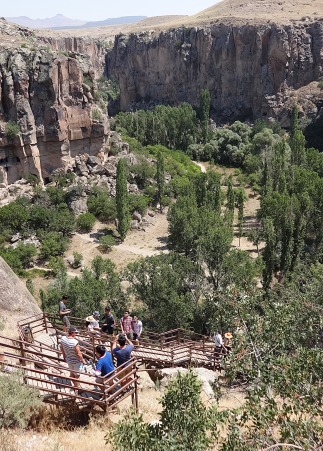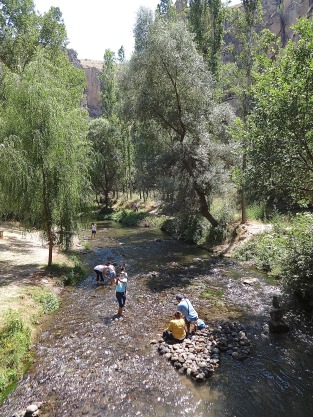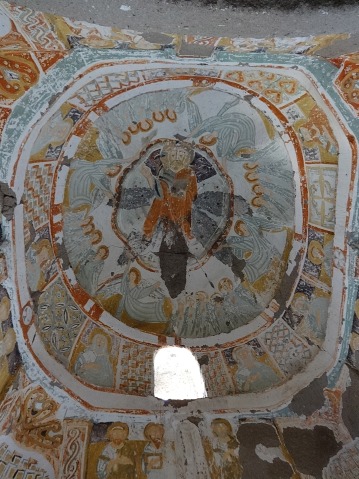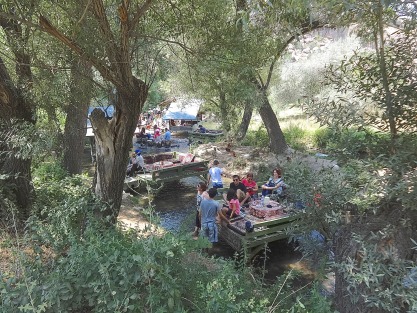Cappadocia’s mini Grand Canyon Population: 2,290
Close your eyes for a moment and picture the scene.
A dramatic gorge slices through the countryside of western Cappadocia, its walls rising sheer from the floor where the Melendiz river trips an idle path past shady willows and grey-green olive trees, and a collection of frescoed rock-cut churches second in importance only to those in the Göreme Open Air Museum.
This is Ihlara, the beautiful canyon that stretches for some 16 km from Ihlara village, south of Aksaray, to Selime, the site of a splendid rock-cut monastery.
Of course it’s fanciful to compare this relative tiddler of a gorge to the seemingly endless splendour of the real Grand Canyon but it’s a breath-taking and unforgettable sight nonetheless and one every visitor to central Anatolia should try to squeeze into their itinerary. The one fly in the ointment is the sheer number of other people who may be trying to discover it at the same time as you these days.
In 2024 sad news showed an intrusive new glass visitor centre nearing completion in the gorge. In pictures it looks wholly out of place. I haven’t seen it for myself. Nor do I want to. I’d rather remember the valley as it was.
 Exploring the gorge
Exploring the gorge
Most tours of the Ihlara Gorge take people to the main entrance outside Ihlara village where they can descend around 400 steps to the valley floor. They then usually turn left and walk along the banks of the Melendiz Çayı as far as the village of Belisirma where they have lunch at one of the many simple restaurants, some of them actually in the water, before being picked up by their minibus for the onward drive to visit the monastery at Selime.
If you want to walk the entire gorge the best place to start is the village of Ihlara, which boasts a defunct riverside hamam and an outsize modern mosque. There’s basic accommodation in the heart of the village along with a small restaurant and shop where you can stock up on basic picnic ingredients, as well as more comfortable places to stay on the rim of the gorge up above.
Stay the night here and you’ll be perfectly placed to make an early start, allowing plenty of time to walk the length of the gorge and examine some of the churches along the way.
It’s at the Ihlara end that the canyon is at its most dramatic, and it’s also at this end that you’ll find most of the 60-odd churches and chapels, mainly dating from between the ninth and 13th centuries. Most are easily accessible, although a few require a bit of climbing, a tough task in the heat of high summer, so bring plenty of water.
As for the path itself, it’s rarely possible to go far wrong as it follows the course of the river. There are only a few sections where you’ll need footwear sturdy enough for scrambling over rocks.
If you want to walk the valley in a single day you’ll need to cherry-pick your churches.
Heading north from Ihlara one of the first that you’ll come to is the Kokar Kilise (Fragrant Church) where tombs are cut into the floor and wonderful late 9th-century frescoes depict the Life of Christ. Unfortunately, as elsewhere in the valley, most of the paintings closest to the ground have been damaged; in particular most of the human figures have had their eyes put out for reasons that vary according to the story-teller (religious reasons, bored children, vandals – take your pick).
Bypassing the Pürenli Seke Kilise (Platform Church) and the Karanlık Kilise (Dark Church, not to be confused with the better known church of the same name in the Göreme Open Air Museum), you will come to the Sümbüllü Kilise (Hyacinth Church), once part of a large monastic complex and easy to identify because of the graceful horseshoe-shaped arches decorating its facade; inside, the late 10th-century frescoes include a fine Pantocrator, and a series of images of saints including St George, the patron saint of Cappadocia, and St Theodore, a soldier-saint much revered during the turbulent Middle Ages when Cappadocia straddled the frontline of many power struggles.
A little further north is the Yılanlı Kilise (Snake Church, again not to be confused with the ones of the same name in Göreme and Soğanlı) where 9th-century frescoes in the narthex graphically depict the Torments of Hell as snakes set about their predominantly female victims.
Nearby in the Ağaçaltı Kilise (Under the Tree Church, AKA Daniel Pantonassa Kilise) there are impressive 9th or 10th-century frescoes of the Three Wise Men in pointy hats and a particularly battered Daniel in the Lion’s Den in the apse where they would more usually be an image of the Virgin Mary holding Jesus.
Shortly afterwards you reach the flight of 360 steps that climb up to the Ihlara Turistik Tesisleri, a shop and restaurant complex where most tour groups make their descent into the valley.
If you keep walking northwards you will come to the Kırk Dam Altı Kilise (Under the Forty Rooms Church, otherwise known as the Church of St George) which contains images of the donor, a local emir called Basil Giagoupes, and his wife Tamara; unusually, an inscription inside the church makes it possible to date the paintings precisely to the period between 1282 and 1304.
It’s also worth looking out for the Bahattın’ın Samanlığı Kilise (Bahattın’s Hayloft Church) where 10th-century frescoes of the Life of Christ were partially protected when Bahattın commandeered the church to serve as his barn.
Then you will reach the path that leads to Belisirma, midway along the gorge, and a cluster of restaurants beside and even in the river itself which make a perfect setting for lunch.
If you’re after a full-on Cappadocian experience you can camp in the grounds of one of the restaurants or put up in the village’s one small pension.
Otherwise the path continues ever northwards, although now the walls of the canyon start to pull back from the water and you’ll find yourself wandering through meadows and alongside irrigation ditches, passing the villagers who still farm the gardens and orchards here, their women picturesquely dressed in thick velvet şalvar (baggy trousers).
The path eventually peters out at the village of Yaprakhisar, but it’s well worth continuing a little further north to Selime. There are few better places to end a walk that is guaranteed to stand out in your memory as one of the highlights of a visit to Turkey.
 Sleeping
Sleeping
Akar Pansiyon, Ihlara. Tel: 0382-453 7018
Belisirma Ev Pension. Tel: 0382-457 3037
Star Pension, Ihlara. Tel: 0382-453 7676
Alternatively, you could stay in Güzelyurt which is nearer to Ihlara than the Eastern Cappadocian hotspots.
Tours to the gorge
These days a visit to Ihlara forms the centrepiece of many organised tours from Cappadocia’s main tourist hotspots — Göreme, Ürgüp, Uçhisar and Avanos — where it’s usually packaged with a visit to an underground city, and to assorted panoramic viewpoints along the way.
These trips take visitors down into the middle of the gorge where they walk for between three and seven km, stopping for lunch near Belisirma (Peristrema).
For people with limited time, such tours are ideal, taking the pain out of trying to get to Ihlara under their own steam. But for those fortunate enough to be able to linger, it’s better to set aside a couple of days to explore the gorge thoroughly, especially since rural life continues there in a way that it barely does in the more developed parts of Cappadocia.
Transport info
If you don’t want to take a tour from eastern Cappadocia you can catch one of the infrequent daily buses from Aksaray to Ihlara where a hotelier may be persuaded to pick you up from the far end of the valley and bring you back to your starting point at the end of the walk.
If business is slow it’s sometimes possible to persuade a tour company to drop you off in Ihlara or Selime and then pick you up again the following day.
“The trouble was that no one seemed to be visiting this remarkable gorge – it remained one of the least known sites in Turkey.” A Time in Turkey, Craig Mair, 1973


